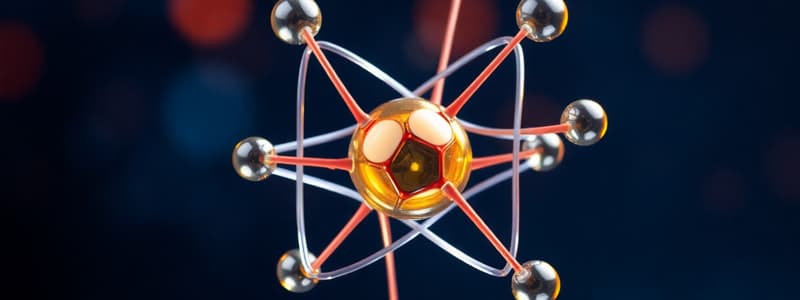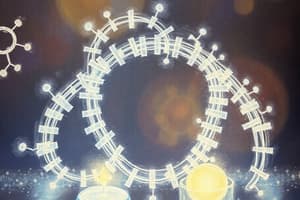Podcast
Questions and Answers
What is the primary purpose of stoichiometric calculations?
What is the primary purpose of stoichiometric calculations?
- To measure the temperature of a reaction
- To determine the amount of products formed or reactants needed (correct)
- To calculate the pH of a solution
- To analyze color changes in a solution
What does a strong acid do when dissolved in water?
What does a strong acid do when dissolved in water?
- Completely dissociates into ions (correct)
- Releases hydroxide ions
- Partially dissociates into ions
- Forms a buffer solution
In redox reactions, what is the role of oxidizing agents?
In redox reactions, what is the role of oxidizing agents?
- They gain protons and cause acidity
- They cause oxidation by losing electrons (correct)
- They release heat during a reaction
- They accept electrons and cause reduction
Which statement accurately describes an exothermic reaction?
Which statement accurately describes an exothermic reaction?
What does the pH scale measure?
What does the pH scale measure?
What defines a substance as an element?
What defines a substance as an element?
Which of the following best describes the difference between a compound and a mixture?
Which of the following best describes the difference between a compound and a mixture?
What determines the atomic number of an element?
What determines the atomic number of an element?
What type of bond involves the transfer of electrons between atoms?
What type of bond involves the transfer of electrons between atoms?
Which state of matter has a definite volume but no definite shape?
Which state of matter has a definite volume but no definite shape?
Which statement about isotopes is correct?
Which statement about isotopes is correct?
What do the groups in the periodic table represent?
What do the groups in the periodic table represent?
What does stoichiometry deal with in chemical reactions?
What does stoichiometry deal with in chemical reactions?
Flashcards
Stoichiometry
Stoichiometry
Calculations relating amounts of reactants and products in a chemical reaction.
Molar Mass
Molar Mass
Mass of one mole of a substance (in grams).
Acid
Acid
Substance that donates a proton (H⁺).
Exothermic Reaction
Exothermic Reaction
Signup and view all the flashcards
Oxidation
Oxidation
Signup and view all the flashcards
Element
Element
Signup and view all the flashcards
Atom
Atom
Signup and view all the flashcards
Compound
Compound
Signup and view all the flashcards
Chemical Reaction
Chemical Reaction
Signup and view all the flashcards
Periodic Table
Periodic Table
Signup and view all the flashcards
Ionic Bond
Ionic Bond
Signup and view all the flashcards
Atomic Number
Atomic Number
Signup and view all the flashcards
States of Matter
States of Matter
Signup and view all the flashcards
Study Notes
Fundamental Concepts
- Chemistry is the study of matter, its properties, and how it changes.
- Matter is anything that occupies space and has mass.
- Elements are substances that cannot be broken down into simpler substances by chemical means.
- Atoms are the smallest units of an element that retain its chemical properties.
- Molecules are groups of two or more atoms held together by chemical bonds.
- Compounds are substances formed from two or more different elements chemically combined.
- Mixtures are combinations of two or more substances that are not chemically combined.
- Chemical reactions involve the rearrangement of atoms to form new substances.
- Physical changes do not result in the formation of new substances.
Atomic Structure
- Atoms have a nucleus containing protons (positive charge) and neutrons (no charge).
- Electrons (negative charge) orbit the nucleus in different energy levels.
- The number of protons determines the element's atomic number.
- The number of protons plus neutrons determines the atomic mass.
- Isotopes are atoms of the same element with different numbers of neutrons.
- Electron configuration describes the arrangement of electrons in different energy levels and sublevels.
Periodic Table
- The periodic table organizes elements based on their properties.
- Elements in the same column (group) have similar chemical properties.
- Elements in the same row (period) have increasing atomic number and varying properties.
- Metals are typically good conductors of heat and electricity.
- Nonmetals are typically poor conductors of heat and electricity.
- Metalloids have properties of both metals and nonmetals.
Chemical Bonding
- Ionic bonds involve the transfer of electrons between atoms, forming ions.
- Covalent bonds involve the sharing of electrons between atoms.
- Metallic bonds involve the sharing of electrons among many atoms.
- Intermolecular forces are forces between molecules, including hydrogen bonds and van der Waals forces.
States of Matter
- Solids have a fixed shape and volume.
- Liquids have a fixed volume but take the shape of their container.
- Gases have no fixed shape or volume and expand to fill their container.
- Phase changes involve a change of state between solid, liquid, and gas.
Stoichiometry
- Stoichiometry relates the quantities of reactants and products in a chemical reaction.
- Chemical equations represent chemical reactions using chemical formulas.
- Stoichiometric calculations involve determining the amount of products formed or reactants needed.
- Molar mass is the mass of one mole of a substance.
Acids and Bases
- Acids are substances that donate protons (H⁺) in a chemical reaction.
- Bases are substances that accept protons (H⁺) in a chemical reaction.
- The pH scale measures the acidity or basicity of a solution.
- Strong acids and bases completely dissociate in water.
- Weak acids and bases partially dissociate in water.
Redox Reactions
- Redox reactions involve the transfer of electrons between reactants.
- Oxidation is the loss of electrons.
- Reduction is the gain of electrons.
- Oxidizing agents cause oxidation; reducing agents cause reduction.
Chemical Reactions
- Types of Reactions: Synthesis, decomposition, single displacement, double displacement, combustion
- Reaction rates are affected by temperature, concentration, surface area, and catalysts.
- Equilibrium describes dynamic balance between forward and reverse reactions.
Thermodynamics
- Thermodynamics deals with energy changes in chemical reactions.
- Exothermic reactions release heat to the surroundings.
- Endothermic reactions absorb heat from the surroundings.
- Enthalpy is the heat content of a system.
- Entropy is a measure of disorder.
Studying That Suits You
Use AI to generate personalized quizzes and flashcards to suit your learning preferences.
Description
Explore the basic principles of chemistry including matter, atoms, molecules, and chemical reactions. This quiz covers the structure of atoms, their components, and the distinction between elements, compounds, and mixtures. Test your understanding of fundamental chemistry concepts.




